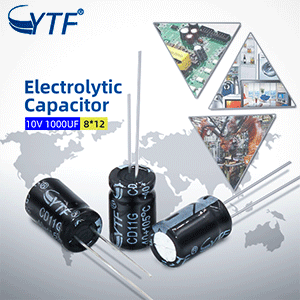Information to Electrolytic Capacitors
1 Capacitor characteristics
YTF Electrolytic capacitor features one: the capacitance per unit volume is very large, tens to hundreds of times larger than other types of capacitors.
The second characteristic of electrolytic capacitors: the rated capacity can be very large, and it can easily achieve tens of thousands of μf or even a few f (but it cannot be compared with the electric double layer capacitance).
The third characteristic of electrolytic capacitors: the price has an overwhelming advantage over other types, because the components of electrolytic capacitors are common industrial materials, such as aluminum and so on. The equipment for manufacturing electrolytic capacitors is also ordinary industrial equipment, which can be mass-produced at a relatively low cost.
2 Principle of capacitance
Electrolytic capacitors are usually made of metal foil (aluminum / tantalum) as the positive electrode, and the insulating oxide layer of the metal foil (aluminum oxide / tantalum pentoxide) as the dielectric. Electrolytic capacitors are divided into aluminum electrolytic capacitors and tantalum electrolysis based on their positive electrodes. Capacitors. The negative electrode of an aluminum electrolytic capacitor is composed of a thin paper / film or electrolyte polymer impregnated with an electrolyte solution (liquid electrolyte); the negative electrode of a tantalum electrolytic capacitor usually uses manganese dioxide. Since the electrolyte is used as the negative electrode (note that it is distinguished from the dielectric), the electrolytic capacitor is named.
3 capacitor application
Polarized electrolytic capacitors usually play a role in power supply filtering, decoupling, signal coupling, time constant setting, DC blocking, etc. in power supply circuits or intermediate frequency and low frequency circuits. Generally, it cannot be used in AC power circuits. When used as a filter capacitor in a DC power circuit, the anode (positive electrode) should be connected to the positive terminal of the power supply voltage, and the cathode (negative electrode) should be connected to the negative terminal of the power supply voltage. , Otherwise it will damage the capacitor.
Non-polar electrolytic capacitors are commonly used in speaker divider circuits, TV S correction circuits, and single-phase motor starting circuits.
Electrolytic capacitors are widely used in household appliances and various electronic products, with a large capacity range, generally 1 ~ 33000μF, and a rated operating voltage range of 6.3 ~ 700V. Its shortcomings are medium loss, large capacity error (maximum allowable deviation is + 100%, -20%), poor high temperature resistance, long storage time is easy to fail.
For the polarity of the electrolytic capacitor, pay attention to observe that there are "-" on the side of the electrolytic capacitor and "+" is the positive electrode. It is a positive pole, and the short leg is a negative pole.
In terms of current output, aluminum electrolytic capacitors occupy the second place among capacitors. This type of capacitor was originally a general DC capacitor, but now it has developed from DC to AC, from low temperature to high temperature, from low voltage to high voltage, from general type to special type, from general structure to chip, flat, book Structure. The upper limit capacity has been extended to about 4F, the frequency of use has reached 30kHz, the operating temperature range has reached -55 ℃-125 ℃, and some even as high as 150 ℃, the rated voltage has reached 700V. In short, the development of aluminum electrolytic capacitors is getting wider and wider. The basis for these developments is as follows:
 YTF
YTF  2023-11-23
2023-11-23
